|
Some
time ago I published a series of articles[i]
in which it was speculated that the Masonic Symbol of the Square and Compasses
may be a Sigil constructed using the Freemasons Magic Square. The Freemason’s
Magic Square is one specific numerical arrangement of the several possible
numerical arrangements of the ancient Magic Square of Saturn. It is the premise
of these articles that the Square and Compasses symbol neatly fits the
three-by-three grid (Figure 1) which comprises the Freemason’s Magic Square
and that by using simple cryptographic techniques such as Alphabet/Number
substitution (employing for example the Pythagorean Chart), some previously
encrypted message may be revealed.
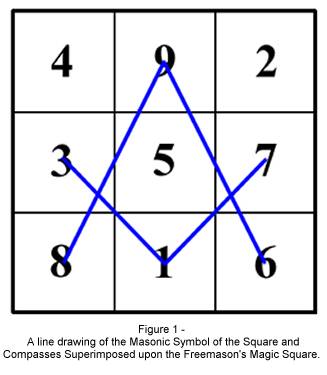
My
purpose for this (the current) article however is not to further acquaint the
reader with the Freemason’s Magic Square or to report the findings of my
ongoing research pertaining to the Square’s possible use or origin as a Sigil.
Instead I intend to present a different sort of analysis by considering the
Square and Compasses as a purely geometric figure constructed within the
three-by-three matrix of the Freemason’s Magic Square. I believe the results
will be interesting to the reader.
Note
that I am fully aware that there is absolutely no historical or factual basis
supporting that this layout of our beloved Symbol is correct; none-the-less,
this exercise does as a minimum lend itself to being a good lesson in
mathematics and geometry. I trust that any controversy which arises from my
musings on this subject will be tempered by this fact. In this article I will present a second construction of the
Square and Compasses which results in identical geometric characteristics. I do
not suggest that the second construction supports my contention of the origin or
use of the Square and Compasses as a Sigil. I do suggest however that the double
square resulting from the construction of a Vesica Pisces and which results in
line segments having lengths equal to the square root of 5, and the square root
of two, is common to both figures.
In
the course of my analysis, I will be making certain assumptions which include
that the reader understands basic principles of geometric construction, the
nature of geometric proofs, and the concept of Divine Proportion[ii]
(the Golden Mean or Phi). Where there is the possibility that the reader may be
unacquainted with the more obscure geometric concepts which I mention, I have
added extensive references where-by he may find basic explanations or further
information.
The
Square and Compasses
The design of the Masonic Symbol of the Square and Compasses varies
significantly. No single “official” design is known to exist, even though
the Square and Compasses symbol has been copyrighted[iii].
In some instances the Compasses are depicted as having a forty-five degree
included angle between the tips, and in other depictions the Square and
Compasses are shown with a much narrower or broader span. Since I began this
discussion with reference to the three-by-three matrix provided by the
Freemason’s Magic Square, this matrix will be the basis for the layout of the
Square and Compasses which I will pursue.
Figure 2 below presents a three-by-three square matrix within which I
have constructed a line drawing of
the Square and Compasses. Since this is a geometrical analysis, I have labeled
the three end points which describe the compasses as A, B, and C and have
labeled the end points of the lines which describe the square as D, E, and F.
Using this convention then, the compasses are formed by line segments A-B and
B-C, while the square is represented by line segments D-E and E-F.
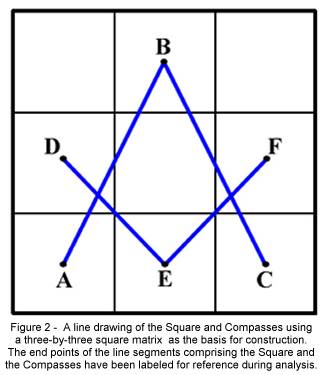
Assume
that each square (cell) in the matrix has a dimension of unity. Therefore each
cell in the matrix is a one-by-one unit square. Note that the ends of the line
segments in the figure begin and terminate in the center of the cells comprising
the matrix, with the result that ends of each line in the figure are positioned
exactly one-half unit from the border of the larger square formed by the
aggregate of the individual matrix cells . Figure 3 illustrates this along with
the dimensions for the horizontal and vertical line components of the Symbol
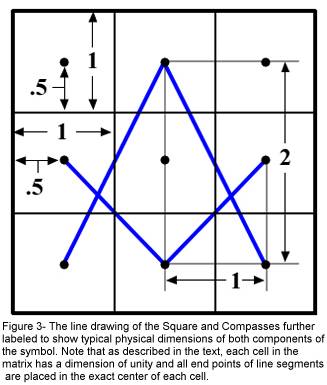
Using
this arrangement the angular dimensions of the “legs” of the compasses may
be derived using the Pythagorean Theorem (The 47th Proposition of
Euclid) as follows:
Pythagorean
Theorem: c2 = a2 + b2
Therefore,
c2 = 12 + 22
And,
c2 = 1 + 4
And
it follows,
c2 = 5
Resulting
in:
c=  5 5
It
follows that the length of both “legs” of the Compasses (line segments A-B
and B-C) are equal to the square root of five. The same derivation may be used
to calculate the length of the “legs” of the Square:
Pythagorean
Theorem: c2 = a2 + b2
Therefore,
c2 = 12 + 12
And,
c2 = 1 + 1
And
it follows,
c2 = 2
Resulting
in:
c=  2 2
Consequently,
the lengths of the “legs” of the Square (line segments D-E and E-F) are
equal to the square root of two. The reader will no doubt note that the square
root of two is exactly the length of the diagonal of a true unit square.
Note
also in our analysis that the symbol of the Square and Compasses exhibits
perfect bilateral symmetry, and that each side of the symbol (left and right of
the center vertical line comprising the matrix) may be enclosed in a separate
double square. This is significant because the double square[iv]
is the starting point for the construction of the Divine Proportion[v].
Divine
Proportion
A
straight (dashed) line may now be constructed which joins the endpoints (points
D and F) of the square (Figure 4). This line intersects the legs of the compasses at their
respective midpoints and also intersects the vertical lines of the matrix at
these same points. We will label the points of intersection, Point “G” and
Point “H”.
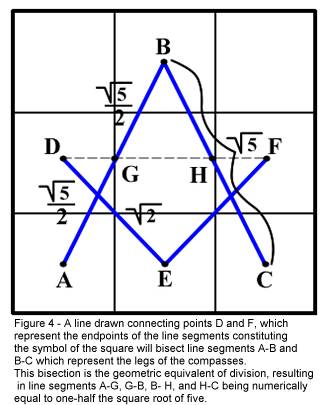
Since
line segments A-B and B-C have been bisected, line segments A-G, G-B, B-H, and
H-C now are equal to one-half the square root of five. This is important because
the mathematical value of one-half the square root of five is exactly one-half
less than the Divine Proportion, Phi. In other words by adding one-half (0.500)
to the value of one-half the square root of five (approximately 1.118034) we
obtain Phi, (1.618034). The golden ratio is also called extreme
and mean ratio. According to Euclid[vi],
a straight line is
said to have been cut in extreme and mean ratio when as the whole line is to the
greater segment, so is the greater to the less. This may be
mathematically derived as follows:
In
a line divided in accordance with the definition of Euclid, let the lesser part
= 1, and the greater part =  . .
Then
by the definition of the golden ratio[vii],
 / 1
= (1 + / 1
= (1 +  ) / ) / 
Therefore,
 2
= 12 + 1 2
= 12 + 1
Which,
yields the quadratic equation,
 2
- 2
-  -
1 = 0 -
1 = 0
Solving
this quadratic equation for the golden ratio  results
in: results
in:
 =
1/2 + =
1/2 +  5
/ 2 5
/ 2  1.618 1.618
In
our construction we are now presented with the opportunity to extend a straight
horizontal line (Figure 5) from Point A to Point I, creating line segment A-I
with a length of exactly one-half unit. If we were to swing an arc with a radius
of A-I from Point A to a point (Figure 5 Point J) in alignment with line segment
A-B, we would have effectively performed a geometric addition of one-half to the
length of line A-B. In so doing we would have produced line segment G-J, having
a length equal to the Divine Proportion (Golden Mean).
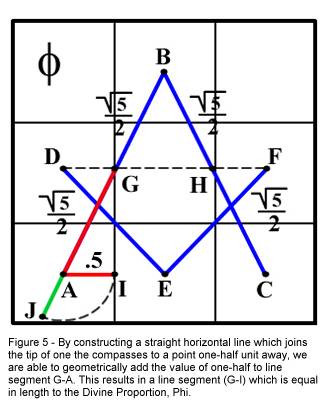
It may further be seen from Figure 5 that line segment G-I also then has
a total length of Phi.
In
Figure 6 we have expanded this concept by extending line segment G-I to Point E,
a distance of an additional one-half unit (Line A-E is one unit in length). The
total length of line segment B-E then is two times Phi.
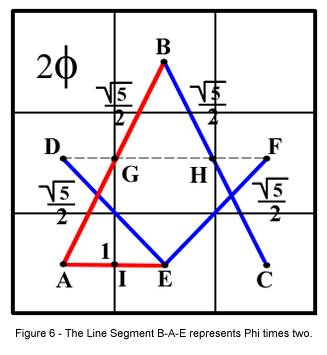
Further extensions may be made to obtain line segments three times and
four times (Figure 7) the value of Phi in length. In one of the following
sections of this article we discuss the “Rope Stretchers”. This property of
this figure might have been of particular interest to this group.
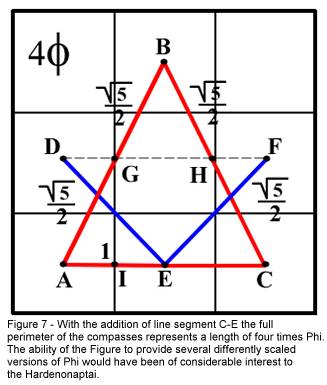
Up to this point we have essentially ignored the geometric properties of
the square other than its geometric function as a bisector of the compasses.
Rest assured however that the square as constructed in our Figure also has
unique geometric properties related to the value of Phi. In Figure 8, a version
of the Square and Compasses is presented in which all except the basic
references to the Compasses have been eliminated.

In this figure, the classic method[viii]
for dividing a line into mean and extreme ratio has been employed. An arc having
radius E-F has been constructed from point F, which intersects line segment D-F
(the hypotenuse of triangle D-E-F) at point G. Another arc of length D-G is then
constructed from point D which intersects Line D-E at point L. In this
construction, the ratio of the length of Line segment L-E to line segment D-L is
equal to Phi. It follows that the same is true of the ratio of line segment E-F
to line segment F-M. Note the precision with which the intersecting point of the
Square and Compasses bisects the legs of the compasses while simultaneously
dividing the legs of the square into mean and extreme ratio.
An Alternate Construction
As discussed, an alternative construction of the Square and Compasses may
be performed in which the Divine Proportion is produced using the identical
elements of the Square and Compasses. In this construction our starting point is
the Masonic Symbol of “The Point Within a Circle” which has been altered by
the addition of a second circle to produce the Vesica Pisces[ix]
(Figure 9). Both circles in our Figure have a radius of one unit. I have labeled
the Figure in a manner that will assist the reader in following the development
of the construction.
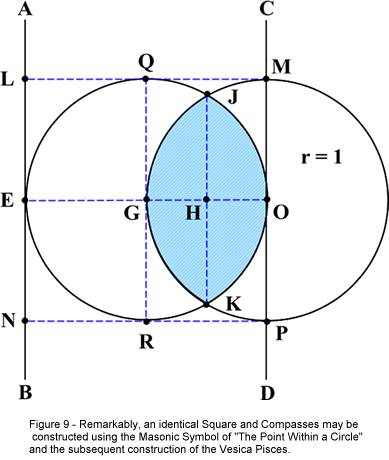
In Figure 10, a line drawing of the Square and Compasses has been added.
Note that the dimensions of the Square and Compasses are consistent with the
dimensions used in the original construction. This is because both constructions
rely upon the creation of a double square.
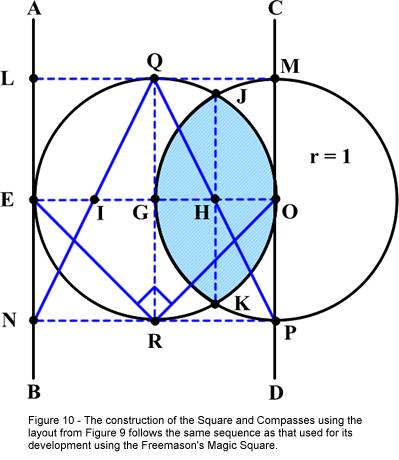
In Figure 11, the construction has been further developed to illustrate
that the value of Phi may be realized in a fashion identical to that utilized in
the original construction. Figure 12 is the completion of the construction
illustrating the creation of two times Phi. It follows that the construction is
capable of producing Phi and three multiples of Phi (one time, two times, three
times, and four times Phi). I chose not to repeat the development of Phi in the
Square, which would be identical to that shown in the original Figure.
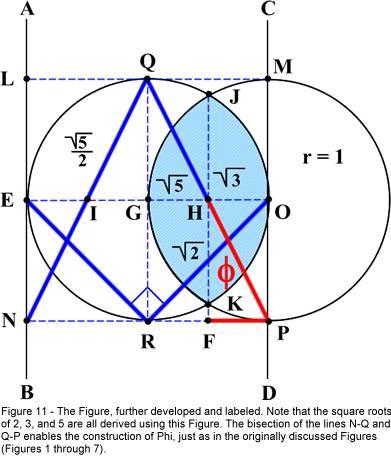
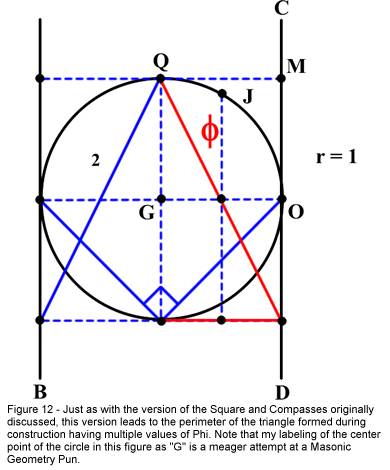
Rope
Stretchers
“Rope Stretchers” is the English translation[x] of the Egyptian word “Hardenonaptai”.
It refers to the ancient engineers or surveyors who were believed to be
responsible for the layout and measurement of monuments. This task was
accomplished using ropes which had been knotted to mark specific dimensions or
measurement reference points. In addition to ropes knotted to produce
subdivisions of units such as eighths, quarters, halves, etc. the Rope
Stretchers used ropes knotted to produce Pythagorean Triples. A rope containing
twelve equally spaced knots[xi],
for example, could be used to construct a 3, 4, 5 triangle, which is the basic
triangle used for proof of the 47th Proposition of Euclid. Diagrams
of figures used by the Rope Stretchers to accurately knot ropes producing
various equal graduations and the Pythagorean triples have survived to modern
times as has an interesting ancient Egyptian sculpture believed to portray the
Rope Stretchers [xii].
It is also probable that the Rope Stretchers had knowledge of Divine
Proportion[xiii].
Recalling our use of the square and compasses figure to construct a line having
a value equal to one-half the square root of five, imagine the ease with which a
rope could be knotted to this dimension, and the further ease with which an
additional knot could be added exactly one-half unit in additional length.
Naturally the laws of proportion apply for our figure, and consequently a rope
knotted at the apex (pivot point) of the compasses, extended to the tips, and
terminated with a knot at the “corner” (right angle) of the square would
also represent the Divine Proportion. A complete circuit of the Compasses would
provide either a large scaled version of Phi, or a rope having a length of four
times Phi.
Conclusion
If indeed the Masonic Symbol of the Square and Compasses symbol was
intended to contain subtle references to Sacred Geometry[xiv],
it is obvious that when the Symbol is drawn in the proportions shown here that
references to Divine Proportion are present in abundance.
[iv]
Reynolds, Mark A. "The Unknown Modulor: the "2.058" Rectangle",
Nexus Network Journal, vol. 5 no. 2 (Autumn 2003).
[ix]
Fletcher, Rachel. Musings
on the Vesica Pisces. Nexus Network Journal (ISSN 1590-5869), vol. 6
no. 2 (Autumn 2004).
[xii]
Nicolaas,
Lucas. Hendrik Bunt, Phillip S. Jones, Jack D. Bedient . The
Historical Roots of Elementary Mathematics. Courier-Dover Publications 1988
ISBN 0486255638
[xiii]
Sarton, George. Ancient Science Through the Golden Age of Greece. pp
117. Courier-Dover Publications. ISBN
0486274950
[xiv]
Lawlor, Robert. Sacred
Geometry: Philosophy and Practice (Art and Imagination) Hudson
(March 1989) ISBN-10: 0500810303; ISBN-13:
978-0500810309
|
![]() News Feed |
News Feed |  Subscribe News by Email
Subscribe News by Email